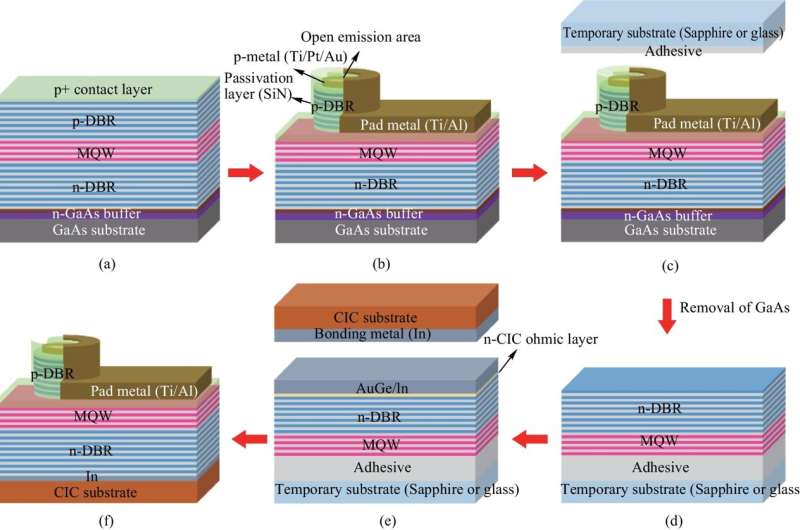VCSEL device transfer procedure onto CIC substrate by double wafer bonding techniques and transfer technologies. Credit: Frontiers of Optoelectronics (2023). DOI: 10.1007/s12200-023-00086-z
Researchers led by Prof. Ray-Hua Horng, a leading expert in semiconductor device technology at Yang Ming Chiao Tung University (NYCU), Hsinchu, Taiwan, China have published a research paper titled "Study on the performance of thin-film VCSELs on composite metal substrate" in the journal Frontiers of Optoelectronics. This work introduces innovative methods that are poised to reshape the landscape of semiconductor technology.
In the study, Prof. Horng explores the remarkable potential of thin film p-side up vertical-cavity surface-emitting lasers (VCSELs). These advanced lasers are engineered on a composite metal substrate known as Copper/Invar/Copper (CIC). The breakthrough is achieved through a novel twice-bonding transfer and substrate removing technique.
The study findings reveal that VCSELs on a composite metal substrate not only significantly influence the characteristics of thin film VCSELs, but also bring about a substantial improvement in the device's thermal performance.
This development is set to completely transform the field of semiconductor device technology, offering enhanced performance and heat management that were previously unattainable.
Prof. Horng's research offers promising applications in various sectors, including telecommunications, data centers, and optical communication. The findings have far-reaching implications for industries and technologies reliant on laser systems for data transmission and signal processing.
This study opens the door to a new era of semiconductor device technology, with the potential to revolutionize the performance and thermal management of not only thin-film VCSELs, but also several high-power electronic devices. It represents a remarkable advancement that could fundamentally alter the future of the semiconductor industry.
More information: William Anderson Lee Sanchez et al, Study on the performance of thin-film VCSELs on composite metal substrate, Frontiers of Optoelectronics (2023). DOI: 10.1007/s12200-023-00086-z
Provided by Frontiers Journals
























